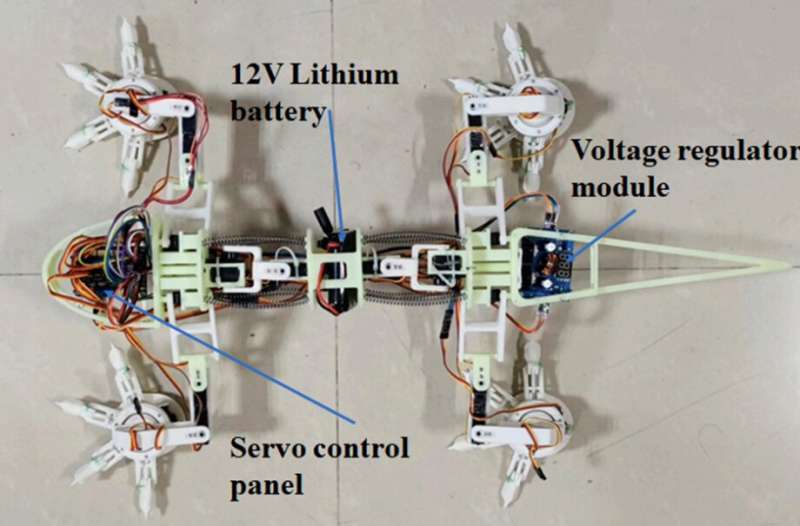February 3, 2023 feature
This article has been reviewed according to Science X's editorial process and policies. Editors have highlighted the following attributes while ensuring the content's credibility:
fact-checked
peer-reviewed publication
trusted source
proofread
A lizard-inspired robot to explore the surface of Mars

Technological advances have opened exciting possibilities for space exploration, which could potentially lead to new discoveries about the celestial bodies in our galaxy. Robots have proved to be particularly promising tools to explore other planets, particularly Mars, a terrestrial planet in the solar system that is known to host some similar elements to those found on Earth.
The exploration of Mars and its surface is a fascinating quest, as it could unveil the signs of past or present extra-terrestrial life. In addition to potentially unveiling forms of ancient microbial life, these explorations could lead to the discovery of resources that exist outside of Earth, potentially paving the way for future human missions to Mars.
Researchers at Nanjing University of Aeronautics and Astronautics have recently developed a new four-legged robot inspired by lizards that could aid the exploration of the red planet's surface. Their robot, introduced in MDPI's Biomimetics journal, has a flexible body structure that can replicate a desert lizard's movements and locomotion style.
"To assist ambitious uncrewed missions to Mars, specific types of planetary rovers have been developed for performing tasks on Mars' surface," Guangming Chen, Long Qiao, Zhenwen Zhou, Lutz Richter and Aihong Ji wrote in their paper. "Due to the fact that the surface is composed of granular soils and rocks of various sizes, contemporary rovers can have difficulties in moving on soft soils and climbing over rocks. To overcome such difficulties, this research develops a quadruped creeping robot inspired by the locomotion characteristics of the desert lizard."
The biomimetic robot created by Chen and his colleagues is comprised of a flexible spine-like structure and four legs. To replicate the "creeping" motion typical of lizards, every leg features two hinges and a gear that elicits a swinging movement.
Each of the hip joints connecting the spine structure with the robot's legs is made of two servos and a four-linkage mechanism that allows the robot to lift without losing its balance. The robot's "feet" have four flexible "toes," consisting of two hinges and a claw.
"The leg structure utilizes a four-linkage mechanism, which ensures a steady lifting motion," the researchers explained in their paper. "The foot consists of an active ankle and a round pad with four flexible toes that are effective in grasping soils and rocks."
To replicate the movements of lizards, the researchers created a series of kinematics models for each of their robot's components. They then used these models and numerical calculations to plan the robot's movements.
"To determine robot motions, kinematic models relating to foot, leg, and spine are established," Chen and his colleagues wrote in their paper. "Moreover, the coordinated motions between the trunk spine and leg are numerically verified."
The researchers initially evaluated their robot in a series of simulations, to determine whether it could effectively replicate the movements of lizards. Their results were very promising, as they found that their robot could perform the desired motions and walking style.
Chen and his colleagues have already created a prototype of their robot using 3D-printed resin materials, a servo control panel, a lithium battery, and other electronic components. They then used a simulation testbed to evaluate their prototype robot's movements on rocky surfaces that resemble the terrain on Mars.
They found that the robot could effectively move in rocky environments, highlighting its potential for future missions on the red planet. Before it can be deployed and tested outside the lab, however, the team will need to develop it further, for instance adding a protective sealing structure that would protect it from soil or airborne dust and building its body using more resistant materials.
Chen and his colleagues are now working on machine learning models that would allow their robot to adapt its movements to different terrains. In addition, they plan to introduce a system that would provide continuous power supply for the robot.
More information: Guangming Chen et al, Development of a Lizard-Inspired Robot for Mars Surface Exploration, Biomimetics (2023). DOI: 10.3390/biomimetics8010044
© 2023 Science X Network




















